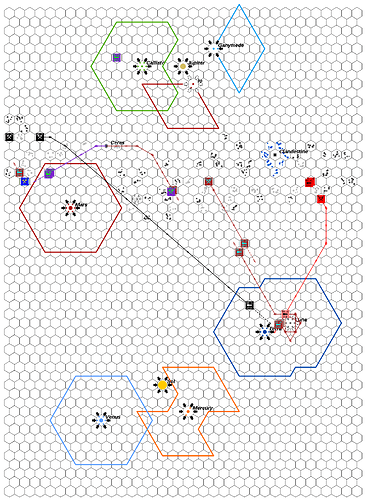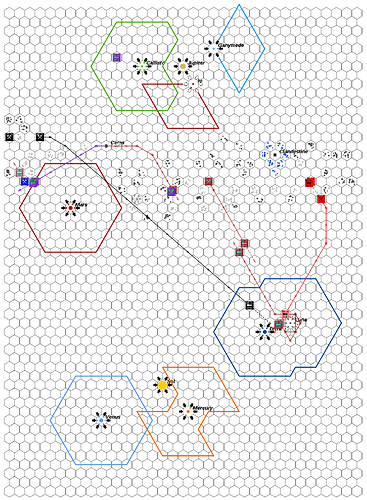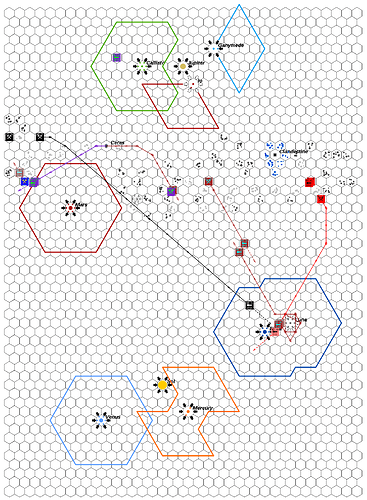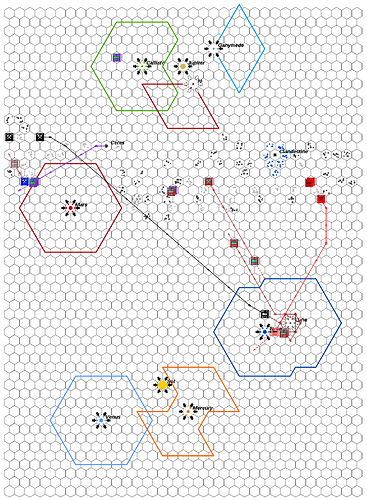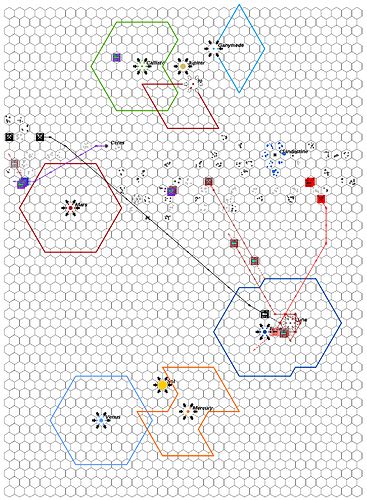I can’t tell if there is any way z6 can match up with t4.
We share the same location and direction now, but not the same speed, correct? t4 is skipping the C acceleration arrow, but can’t skip the B next turn.
If I’m correct about t4’s vector (i.e. that it has to take the B gravity acceleration), then these are my orders:
z1 coast, wave to z2
z2 coast, wave to z1
z3 mine
z4 coast
z5 drift in orbit, repair to D3
z6 coast in orbit
z7 thrust F. Making a run for it.
It’s my understanding that I have to take both the B from Luna and the E from Terra.
If that’s the case, I believe it means z6 will not take the B acceleration next turn.
Or,. Hm. I think I need to be sure about what happens.
Sorry - Maybe just editing a post is a bad idea. For z6 orders, I need to be sure I understand t4 next turn.
OK. t4 right now has a vector of DD. Its position at the end of turn 56 is determined: the first hex it will enter is the one west of Luna, where it has the option of picking up a B acceleration for turn 57. Then it will enter the hex east of Terra, where without the option it will gain an E.
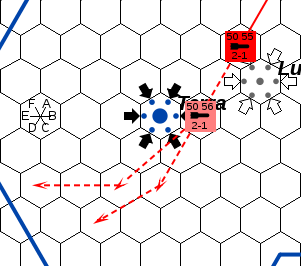
So there are two places where it might be at the end of turn 57 (first dashed arrowheads), and each of them has an exit vector based on which of Earth’s gravity hexes is entered (second dashed arrowheads, either F alone or F+A). Even if the ship isn’t hit again, it won’t recover until after turn 60’s manoeuvres.
It makes life easier for me if you make a new post, because that then shows up as new; I don’t generally look back through old posts.
I think that means I’m going to pass on the attempted intercept of t4. z6 will continue in orbit with z5. I’m not so bloodthirsty as to fire on t4, though. Rescue is possible for a while.
Coast. Fire on z7. d1 writes a strongly worded protest about the incompetence of my manuever planning department.
Range is 2, Δv is 2 (DE -F = DD), so -2 at 4:1.
@discobot roll 1d6
4
is a D3 for z7.
Turn 56 begins. Disabled ships expected to recover:
z7 after turn 58 player 5
z5 after turn 59 player 2
t4 after turn 60 player 2
@MrTim to play.
T1 will mine, t4 will avoid the gravity at Luna.
Shurely z7 never since it will be off the edge of the universe by then? (Speaking of which, r3 is really very inconveniently positioned for looting by passers-by. Most inconsiderate of you.)
I fear I have yet another rules question related to the business above about being “in orbit”. Where I thought we might be ending up is that “in orbit” is as defined originally - on an orbital path - but you can’t do transactions (sell ore, collect ore, drop mines, mine ore, buy fuel, buy mines or guards, load ordnance, etc) on a turn you apply thrust. I’m not sure this is entirely consistent with play so far (eg if I’m not mistaken z7 has just collected ore without spending a turn stopped) but I’m not complaining about that not least because I don’t think anything is consistent with play so far.
The question I have now - which seems related to the above - is whether one can loot a disabled ship, or assist a friendly ship, on a turn one applies thrust, or whether one matches courses on turn N, loots/assists on turn N+1, thrusts away on turn N+2. It seems like this might be coming up near Luna, but also I might want to transfer fuel between my packets.
Yes, z7 will be lost. So will its cargo unless it’s intercepted (which I think may be just barely possible for you if you roll well for high-speed asteroid interactions, though I haven’t worked it out in detail).
One problem is that we have scenario-specific rules interacting with the main rules, so there are various states and things you can do in them. This is what I’m aiming to work with, and if I get it wrong that’s probably an error:
- same position and velocity at the end of your movement - lets you transfer stuff between two ships (same owner, or one is disabled, or by agreement). That’s what’s going on with the mine pickup. Looting/capturing disabled ships, or assisting friendly ones, is definitely allowed here. That stuff happens in phase 5.
- spent the turn without moving or applying thrust - lets you deploy an automatic mine, and/or mine yourself (in phase 3).
- in orbit - moved on an orbital path without applying thrust - lets you trade, refuel, etc. in phase 5.
@EyeZee to play.
It was a 50/50 shot for z7. Ah well.
z1 coast
z2 coast
z3 mine
z4 thrust F to stop. Load ore.
z5 drift in orbit, repair to D2
z6 coast in orbit
z7 drift/repair (It will come to d0 off the map and out of game. It will probably seek employment later as a free trader at Vesta)
I hadn’t planned to try and intercept z7 partly because I thought this ruling would be different, but even now I don’t think I can.
If I’m correct, there is a fourth state; “moved on an orbital path (without regard to thrust application)” which lets you land, and is called “in orbit” in the landing rules. As such I submit the third state should not begin “in orbit”. : -)
Oh, and there’s a question coming as to whether one is also required not to apply thrust to trade at an asteroid base… or rather, on reflection the idea that the third state is called “not manuevering” and it is that which lets you trade if you are in the right place, where the right place is at an asteroid base or fourth state “in orbit”.
“in orbit” is not defined anywhere in the rules, which is why I defined it (back at the top of the thread) as the non-thrust version.
For an asteroid base, you need to be on its hex and with the same velocity (i.e. 0), which comes under case 1.
r1 thrusts F.
@denisbloodnok to play.
At the top of the rules “in orbit” is defined as being “with a vector that will carry it, at speed 1, from one gravity hex to an adjacent gravity hex of the same body”. There is no mention of not applying thrust.
Furthermore, “a minimal approach and landing consists of, on turn N, entering a gravity hex and adjusting velocity so as to be in orbit or at speed zero; on turn N+1, having perhaps moved one hex round the orbital path, applying one thrust to land”; the ship in that example was “in orbit” on turn N, a state that included the application of thrust. (But perhaps we mean that it entered the state of being “in orbit” at the very end of turn N, and it landed on N+1 as a thing a ship in orbit can do, instead of eg trading? I think I do see what you’re getting at.)
d4 d5 thrust A.
